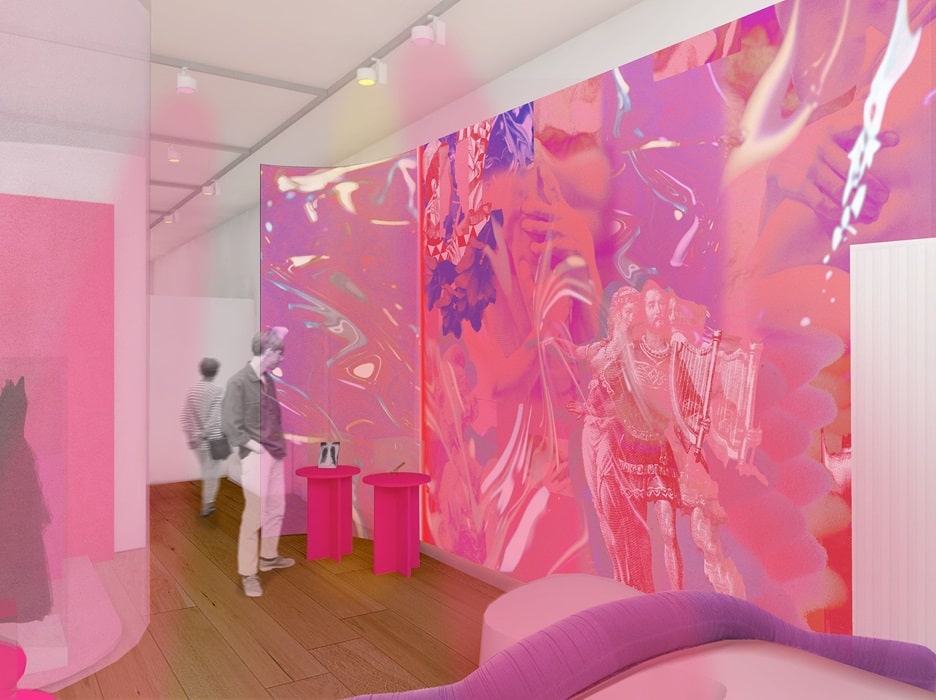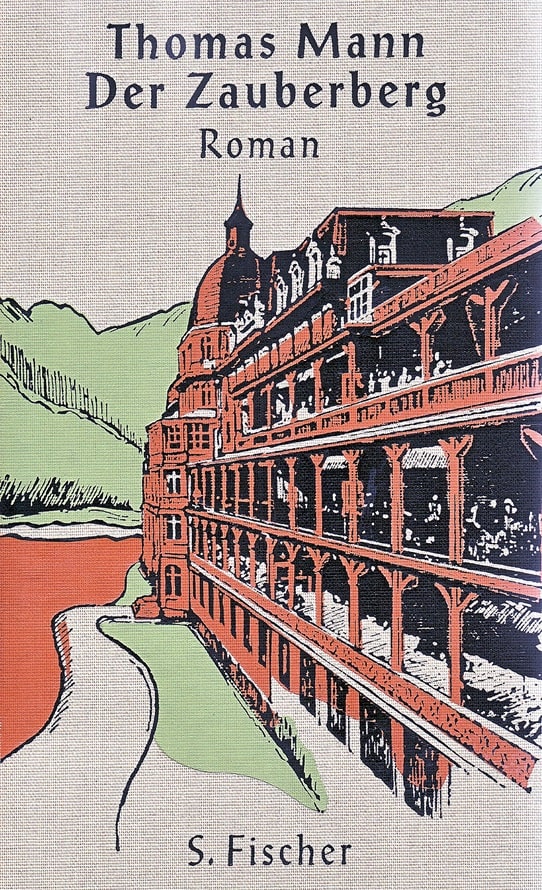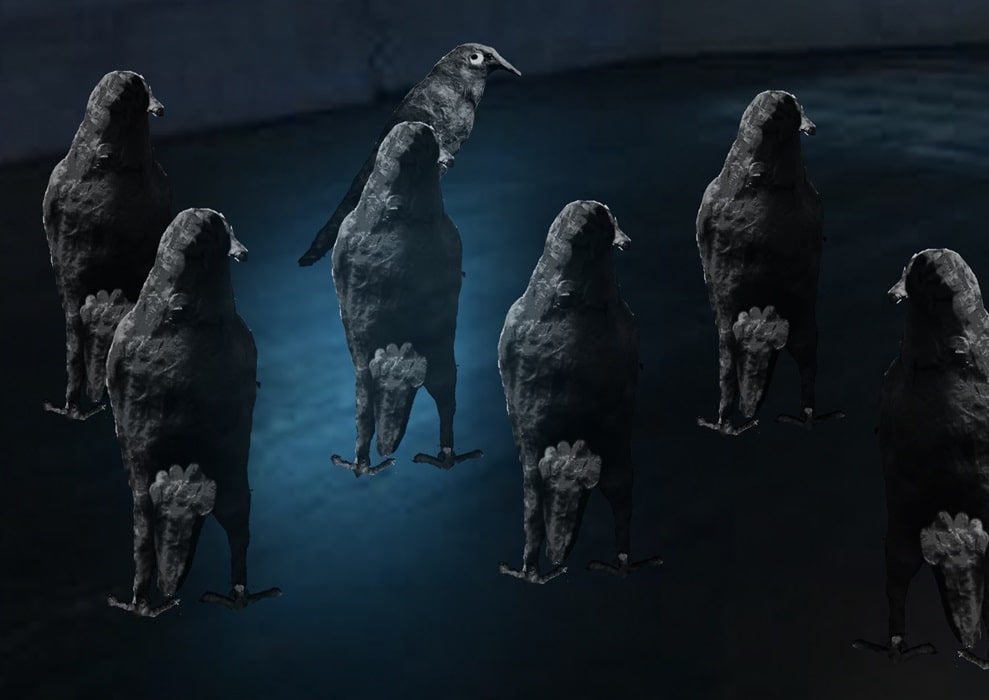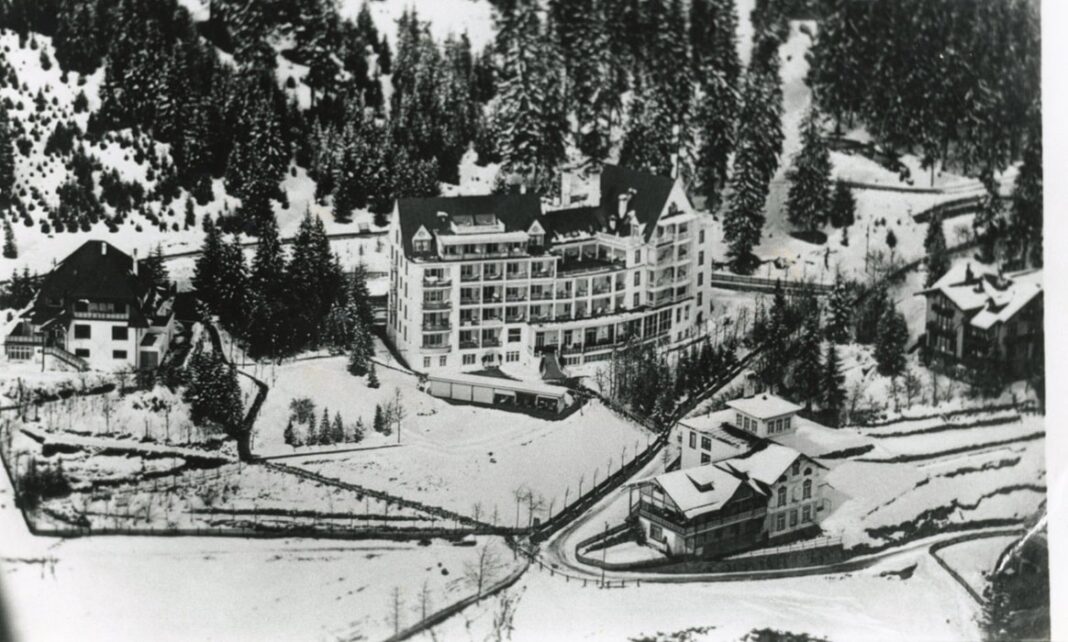From September 14, 2024, Lübeck celebrates 100 years of “Der Zauberberg”(The Magic Mountain). The city where Thomas Mann was born is dedicating the entire St. Annen Museum Quarter to the global bestseller. Three LÜBECKER MUSEEN museums will be marking the anniversary in their programs: a cultural history exhibition at the Buddenbrookhaus, interventions in the medieval collection of the St. Annen Museum and a contemporary art installation by British artist Heather Phillipson.
Image above: Luftbild Davoser Höhenklinik, Archive Günther Schwarberg, Hamburg
Thomas Manns: Der Zauberberg: Fiebertraum und Höhenrausch (The Magic Mountain: fever dream and high altitude)
The exhibition “Thomas Mann’s Der Zauberberg: Fiebertraum und Höhenrausch” at the Buddenbrookhaus tells of the central themes and conflicts of the novel: death and life, desire and love, war and peace. The exhibition links these timeless themes closely with our present day through topical references. The novel, which is set on the eve of the First World War, still has parallels with our times a hundred years after its publication: Nationalism, a lack of scientific knowledge, ignorance and hate speech are relevant across all temporal breaks and epochal changes.
“The Magic Mountain” tells the story of Hans Castorp, a young man from Hamburg, who goes on a three-week vacation to a Swiss lung sanatorium – only to end up staying for seven years. There, at the “Berghof”, Europe’s tuberculosis-stricken elite meet and confront Hans Castorp with the big issues of life. Only the “thunderclap” of the First World War ends all pondering in the novel.
Inspired by a visit to a sanatorium in Davos, which Thomas Mann had become acquainted with during a visit by his wife Katia, he began work on “The Magic Mountain” in 1913. After the war and the collapse of the German Empire and the reconstitution of society as a democratic republic, he completed the work, which was published in 1924 and became a world bestseller as “Der Zauberberg” (“The Magic Mountain”).
A journey through seven exhibition stations
Seven is the magical and structuring number of the “Magic Mountain”. Accordingly, the exhibition is divided into seven sections, which make the almost 1000-page novel of world literature visible, audible and tangible on 250 square meters – not recreated in the Davos spa setting, but dedicated to its philosophical content. The interventions of the present are always new and surprising.
It begins with the story of the novel’s genesis: visitors are given a glimpse into Thomas Mann’s study and the wealth of texts and discourses that Thomas Mann incorporated into “The Magic Mountain” at a time when the world was undergoing radical change. The long 19th century ends with the civilizational rupture of the First World War, old orders disappear and new ones seek to establish themselves. At the same time, the mechanization of medical diagnostics, which is also the subject of “The Magic Mountain”, is progressing at a rapid pace. Together with Hans Castorp, we embark on a journey to the Berghof lung sanatorium. From historical medical objects to today’s smartwatches, the exhibits show how bodily functions were measured and evaluated in the novel and today. As our attention constantly revolves around the recorded body data, it becomes a central part of our lives.
In addition to diagnostics and body control, the exhibition also addresses the topic of treatment. The myth of the good air of the Swiss Alps as a cure for consumption seems strange today, but air quality sensors are nevertheless enjoying brisk acceptance. Using medical instruments and healing objects from the past and present, the exhibition shows how the themes of the novel affect people then and now and literally demonstrates the topicality of the text.

This also applies to the four exhibition sections dedicated to Hans Castorp’s inner life, his dreamlike exploration of the essential characteristics of life. These include finiteness and death, eroticism and desire, social interaction and violence – and the longing for meaning. There is a particular focus on the erotic desire that makes Hans Castorp linger in the sanatorium and which is hardly any different from the escapism of our day. Consequently, an oversized, organically shaped piece of seating furniture invites you to linger. Surrounded by slightly psychedelic wall graphics in which limbs entwine, it is difficult to stand up. The close-ups of the wall design may seem pornographic, but they are actually close-ups of antique sculptures.
The political disputes between the two adversaries Naphta and Settembrini, which are clearly depicted in the novel, bear witness to the “great irritation” of our time. In the exhibition, however, current quotations take the place of the novel’s sprawling character dialogs. The characters’ worlds of thought and disputes are not from yesterday, but are frighteningly contemporary. Here, too, it becomes clear how similar the tonality of the political agitators of the past is to that of today.
Like The Magic Mountain, the exhibition ends with violence and war. The final question is “Will love one day rise from this world festival of death?” – and it is up to the audience themselves to find an answer and develop it in the exhibition space.
“It was important to us in our anniversary exhibition on the novel to make it clear what the modernity of the text consists of, namely in addressing topics and questions that have preoccupied mankind since the beginning of time. The ‘Magic Mountain’ may now be 100 years old, but it has lost none of its freshness and relevance. We wanted to express this. Naturally with the aim of making visitors want to read or re-read the novel.”
– Dr. Caren Heuer, Director of the Buddenbrookhaus since February 2024
The Magic Mountain exhibition at the Buddenbrookhaus will be shown at the St. Annen Museum Lübeck, as the Buddenbrookhaus is closed for renovation. The exhibition makes use of the opportunity and incorporates seven stations in the sacred, medieval collection of the St. Annen Museum as Magic Mountain interventions. The selected objects – from the epitaph to the mourning Mother of God – show that Thomas Mann’s novel “The Magic Mountain” points not only to the present, but also to the past.
The exhibition “Extra Time” by British artist Heather Phillipson, which takes an artistic approach to the novel, opens at the same time as The Magic Mountain at the Kunsthalle St. Annen. With expansive multimedia installations, she transforms the Kunsthalle into a walk-in work of art through which visitors can dreamwalk. She uses a variety of media, from video art, sculpture and music to texts and drawings.

Accompanying program to “Thomas Mann’s The Magic Mountain. Feverish dream and high-altitude rapture”
The program of events to mark the 100th anniversary of “The Magic Mountain” runs throughout the year. The actress Meike Rötzer performs the novel in one hundred minutes. Readings and lectures take up the themes of the novel: Harald Jähner (Höhenrausch. Das kurze Leben zwischen den Kriegen), for example, will focus on the period in which the text was written, while Daniel Schreiber (Zeit der Verluste) will look at dealing with death and grief. A special highlight is the top-class panel discussion “Zeitsprünge/Standpunkte: The Great Irritation”. Moderated by Prof. Dr. Heinrich Detering, German scholar and Leibniz Prize winner, Nicole Diekmann, ZDF capital correspondent, and media scientist Prof. Dr. Bernhard Pörksen will discuss the brutalized debate culture of our time based on “The Magic Mountain”.
The Nordic Film Days are dedicating this year’s retrospective to “The Magic Mountain”, while the Thomas Morus Academy Bensberg is organizing a four-day Magic Mountain Journey together with the Buddenbrookhaus. Another highlight is the “Magic Dinner on the Magic Mountain”. As in the dining room of the Berghof, guests will meet the literary characters Settembrini and Hofrat Behrens over a Swiss menu. Those who attend the multifaceted lecture series “Magic Mountain. Visits to the Present” – a collaboration between the Buddenbrookhaus, Lübeck University of Music and the University of Lübeck – you can read all the contributions in the exhibition catalog and/or stream them on YouTube.
Mediation offer for “Thomas Mann’s The Magic Mountain. Fever dream and high altitude intoxication”
A literary city walk entitled “Davos lies on the Trave. On the trail of the Magic Mountain through Lübeck” shows the surprising cross-references of the novel of the century in the Hanseatic city. The world of the “flatlands”, which Hans Castorp from Hamburg seeks to leave behind, has its roots in Lübeck and was biographically experienced here by Thomas Mann. “‘The Magic Mountain’ is inconceivable without Thomas Mann’s Lübeck origins,” explains Heuer.
In a digital escape game, you accompany the main character Hans Castorp to the Berghof. The aim is to leave the sanatorium as quickly as possible; however, rising fever curves, erotic temptations and a life far removed from any personal responsibility prevent him from leaving. The game can be downloaded free of charge from the Buddenbrookhaus website.
Workshops ranging from literary modernism to the analysis of political texts are offered for secondary school students. For children, “The Magic Mountain” has been specially rewritten into a fairy tale suitable for children.
Catalog
The exhibition is accompanied by a catalog containing texts by the two curators Dr. Caren Heuer and Dr. Barbara Eschenburg as well as academic lectures from the lecture series “Magic Mountain. Visits to the Present”, which look at the novel from different perspectives. Contemporary historical, medical, musicological, literary and cultural-historical perspectives are combined to create a comprehensive kaleidoscope.
Heather Phillipson: Extra time
To mark the 100th anniversary of Thomas Mann’s novel The Magic Mountain, British artist Heather Phillipson is transforming the Kunsthalle St. Annen into a walk-in work of art from September 13, 2024. For her solo exhibition, she draws significant inspiration from the motif of time and social change, which play a central role in The Magic Mountain. The novel is about the individual experience of time against the backdrop of epochal upheavals before the First World War.

In Extra Time, the former church of the St. Annen monastery becomes a portal for dreams and visions of an alternative present and possible futures. The main protagonists of the artistic staging are crow-like characters that populate the entire exhibition space. Crows are considered to be one of the most intelligent bird species. Their mysterious and prophetic call has also made them the subject of numerous myths and legends, often appearing as harbingers and instigators of great upheavals. In the exhibition, they come together in mass gatherings, swarm out, observe, consult, protest and dream. “As the title Extra Time, a term borrowed from soccer for the stoppage time at the end of a game, suggests, the exhibition attempts to convey a sense of overflowing time, an excess of time, a time outside of the allotted time in which it passes differently and challenges our sense of time,” says the artist.
Phillipson’s scenes also refer to the city of Lübeck, which, alongside Mann’s novel, is another important reference for Extra Time. As is characteristic of her way of working, Heather Phillipson immersed herself in the city and allowed its images, sounds, smells and stories to take effect. The crows that populate the city and its playgrounds and sports fields, especially in the early hours of the morning, motivated the artist to translate this mysterious atmosphere into richly detailed spatial collages and surreal environments. Visitors to the Kunsthalle St. Annen stroll through soccer pitches strewn with oranges, between protest camps, playgrounds and skies, through four-dimensional images, as it were.
Heather Phillipson developed the exhibition, which leads through the individual rooms as a course, especially for the Kunsthalle St. Annen and only here can it be experienced in its entirety. The artist incorporates the ascending architecture of the exhibition building, which can be climbed by visitors over three floors, symbolizing the Magic Mountain.
In her expansive installations, Phillipson combines a variety of different media – from video, collage, sculpture, music and digital media to murals, drawings and texts. In Extra Time, she succeeds in creating a sensual connection between her art and central motifs from Thomas Mann’s novel and the urgency of our present.
The Extra Time exhibition is accompanied by a wide-ranging program of events and educational activities. Among other things, visitors can look forward to dialogical tours and workshops with artists. They can also look forward to joint parties and popular formats such as the Art Dinner and the St. Annen Talk, which offer space for encounters, music, culinary delights and conversation.

Heather Phillipson
Heather Phillipson (* 1978, UK) is an award-winning artist and poet. In 2022 Phillipson was nominated for the Turner Prize. Her recent projects include a new commission for Art Night 2023 in collaboration with the Art Fund’s Wild Escape program and the BBC Archive, a commission for the Duveen Galleries at Tate Britain, London (2021-22), commission for the Fourth Plinth in Trafalgar Square, London (2020-22) and a large-scale project Art on the Underground at Gloucester Road station (2018). Her work has been exhibited internationally, including at the Serpentine Galleries, Whitechapel Gallery London, New Museum New York, Palais de Tokyo, Schirn Frankfurt, Sao Paulo Art Biennial (2016), Athens Biennial (2018) and Sharjah Biennial (2019). Phillipson is also a renowned filmmaker and received the Film London Jarman Award in 2016 and was selected for the European Short Film Festival of the International Film Festival Rotterdam in 2018 as well as several awards for her poetry. In 2024 Phillipson will realize a new commission for the Imperial War Museum’s 14-18 Now Legacy Fund in collaboration with the Glynn Vivian Gallery, Swansea, and a new permanent commission for Hospital Rooms, United Kingdom.
WHEN?
Opening: September 13, 2024
Exhibition dates: September 14, 2024 to March 2, 2025
Opening hours: Tuesday – Sunday: 10:00 – 17:00
WHERE?
Buddenbrook House
Mengstrasse 4
23552 Lübeck
St. Annen Museum
St. Annen-Straße 15
23552 Lübeck
COSTS?
Day ticket 12 EUR
2-day ticket 16 EUR






